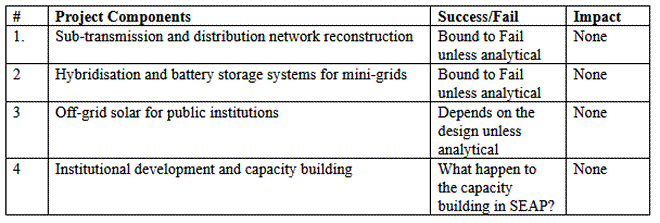by Jacfar Jimcale
Saturday October 22, 2022
The World Bank (WB) is launching the Somali Electricity recovery Project (SERP) which will cost 150M USD and its worth mentioning that the money is not coming from WB account. It comes from Multi-partner Fund (MPF) account which is managed by the WB. Countries like EU, Japan and UAE have pledged to support Somalia and paid this 150M.
In 2013 during the creation of the economic recovery plan (ERP), the notion of upgrading the electrical infrastructure was proposed. The WB appears to be nearly ten years behind in the country's rebuilding efforts. As of 2015, practically all significant urban areas had 11 KV distribution systems invested by the private sector.
Clearly, 150M will not build a national grid and that is why the project has other components in small print. One of these components is to facilitate interconnection between Electricity Service Providers (ESP) within Mogadishu, for example, and within neighbouring cities. However, I would like to remind the WB that they could not interconnect the communication companies, which only requires software code, despite spending over 8M USD. The physical interconnection between competing ESP’s will definitely pose more challenge than the communication companies.
But why do we need to interconnect the ESP’s in the first place? What is the point? And why do we need centralised nitional grid? I mean I understood the need for interconnecting different mobile companies in Somalia which means I don’t have to carry two sets of mobile phones to call my friends, but why ESP’s? If the answer is reducing costs or paving the way for National grid, we are all missing the point.
There will be no cost reduction, even if the ESP’s agree and the development of National grid in Somalia is uneconomical at best. Somalia has fast territory, geographically stretched and loosely populated. Decentralised local mini-grids combined with Solar PV generation is the only way forward for national electrification. The only interconnection needed in Somalia is regional interconnection with the Ethiopian grid but the WB thinks that Somalia is not ready for regional interconnection without national grid. How about the border cities such as Beledweyn? Beledweyn has 11 KV local grid and is 50KM away from the Ethiopian grid.
1. The completed SEAP
In 2014, WB commissioned the ‘electricity Master Plan for Somalia’. This rather abstract document costed one million US dollars. In the following year, a 5.5 million Somali electricity access project (SEAP) was launched. Let’s have a look of this project’s components and how much have been achieved. Table 1 bellow shows the Project components, weather they have been completed and its impact.
Table 1: Project
components and impact.

Let us examine the components one by one:
a. Component 1 (US$ 3M): Electrification of households and small businesses through standalone solar home systems.
It was clear for any energy expert and/or practitioner with cultural knowledge of Somalia, that electrifying the nation with pico-solar will be waste of time and resources. The average number of households in Somalia is six and culturally boys and girls don’t share room which means even the poor village people will have more than two rooms requiring more lighting areas. But the WB decided to supply 10W Pico-Solar to 300,000 households in Somalia and called “Electrification of households and businesses”. What would you do with 10W? I did advice the WB about the pico-solar application in Somalia during ERP development in 2013.
Less than 10% of the pico-solar distributed are currently in use. In Somalia, more than 90% of adults have a mobile phone with a lighting function. These phones called ‘Niicle’ in Somalia, costs £10 and while WB solar latrine from the WB costs £20 without the ability to call your mother. Which one of the two would you keep?
b. Component 2 (US$ 1M): Analytical work for enabling electrification through solar powered/hybrid mini-grids;
a) Detailed geospatial mapping;
b) Review of property rights and land issues;
c) Pre-feasibility studies for hybridization;
d) Pre-feasibility studies for greenfield (new) sites;
e) Developing structuring options for the financing, operation, and ownership of new mini-grids;
f) Defining legal, institutional and financing arrangements for developing mini-grids.
In component 2, it’s about writing reports and as far as I know only two have been completed (a and f) by an international company based in Afghanistan.
c. Component 3 (US$1.5M): Technical Assistance, Capacity Building and Project Management - not even initiated. No such activities have been undertaken unless this too was analytical. If the WB wrote reports on TA, capacity building and project management on Somalia, I have not seen them.
2. Proposed SERP Project
Which component of the proposed SERP will fail?

3. Recommendations
a. Recommendation for the WB• Make a U-turn on this project and go back to the Basics. A country owned and country let projects that are aligned with the priorities.
• Turn your rather powerful energy coordination office into Somalia Electricity Agency and work with the Ministry of energy.
• Increase the energy generation with sizable renewable energy sources.
b. Recommendations for the Government• Take the lead and align the donor partners projects to national priorities
c. Recommendations for the ESP’s• Forget about the donor assistance and electrify the nation by investing steam turbines as the country needs energy to develop.
d. Recommendations for me• Ignore about Somalia and its energy sector and go back to London, UK.
It is now obvious that neither the intended targets nor myself will even consider any of the aforementioned recommendations. I believe that business as usual will proceed.
Jacfar Jimcale
Energy Expert
Mogadishu, Somalia
[email protected]